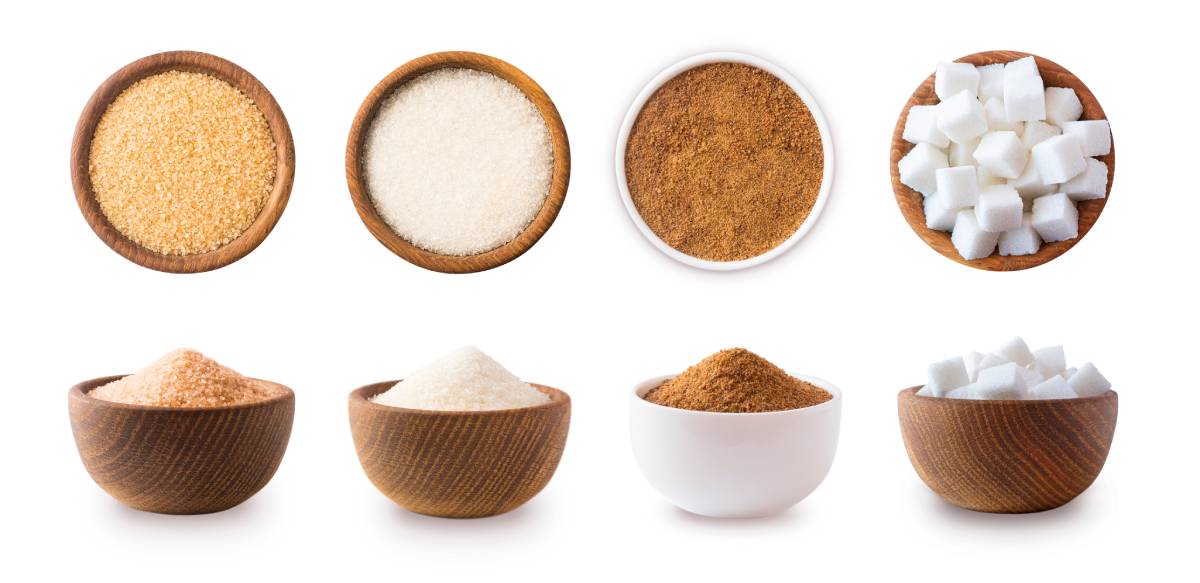Types of Sugar
Though most of us might picture cubes or spoonfuls of white granules when we think of sugar, its identity and precise chemical makeup are much more multifaceted. Understanding the differences between various types of sugar, and their impact on health, can help people make better dietary and health choices.
All sugars are carbohydrates, a type of molecule that can be broken down for energy. Sugars can further be classified into two types of carbohydrates: monosaccharides, which consist of one ring of carbon molecules, and disaccharides, which contain two such rings. Glucose, fructose, and galactose are all monosaccharides, while sucrose (the chemical name for table sugar) and lactose (the sugar found in milk) are disaccharides.1
A key distinction regarding sugars – one which consumers have become more aware of ever since the Food and Drug Administration mandated in 2016 that it be made explicit in the Nutrition Facts on packaged food 2 – is whether they are natural or added. Natural sugars are found in fruits, vegetables, dairy, and honey, while added sugars are added to foods during manufacturing and processing. Consumption of added sugars is associated with numerous negative health effects, such as weight gain, higher risk of type 2 diabetes, and cardiovascular disease. The National Health and Nutrition Examination Survey, which assesses the health of Americans, found that most Americans consume more than the recommended amounts of added sugar, which is associated with an increased risk for cardiovascular disease mortality.3
Natural and added sugars include the same types of sugar. Added sugars are chemically identical to their natural counterparts, and there’s nothing inherently worse about added sugars. Natural sugars are healthier, however, because the foods that have them also contain nutrients such as fiber (in fruits), protein (in milk), and vitamins and minerals (in both). In addition to being necessary parts of a healthy diet in their own right, these nutrients can also regulate how the body breaks down sugar. Fiber, for example, helps regulate blood sugar levels, which is especially beneficial for those with diabetes.4 Additionally, foods with added sugars, such as sodas and sweetened snacks, often have more sugar than foods with natural sugar, making it easier to consume too much sugar and incur the health consequences.
High fructose corn syrup (HFCS) is a type of sugar composed of a mix of glucose and fructose and used in some foods as a sweetener. Though it’s often assumed to be metabolized differently than table sugar, or to have more calories, HFCS is not any less healthy than sucrose.5 Other types of sugar differ in their carbohydrate makeup, taste, and consistency, but likewise do not significantly differ in their nutritional qualities. These include honey, agave syrup, simple syrup (boiled water and table sugar), and brown sugar (table sugar and molasses).
Limiting sugar intake of all types is recommended by health professionals, and a variety of artificial sweeteners exist, such as stevia and aspartame, that lack many of the health risks associated with sugars (but have health risks of their own). To summarize the scientific and medical consensus to date: on a nutritional level, all sugars are essentially created equal.
References
1. Yahia, E. M., Carrillo-López, A. & Bello-Perez, L. A. Chapter 9 – Carbohydrates. in Postharvest Physiology and Biochemistry of Fruits and Vegetables (ed. Yahia, E. M.) 175–205 (Woodhead Publishing, 2019). DOI:10.1016/B978-0-12-813278-4.00009-9.
2. Magnuson, E. A. & Chan, P. S. Added Sugar Labeling. Circulation 139, 2625–2627 (2019), DOI: 10.1161/CIRCULATIONAHA.119.040325
3. Yang, Q. et al. Added Sugar Intake and Cardiovascular Diseases Mortality Among US Adults. JAMA Intern. Med. 174, 516–524 (2014), DOI:10.1001/jamainternmed.2013.13563
4. Lattimer, J. M. & Haub, M. D. Effects of Dietary Fiber and Its Components on Metabolic Health. Nutrients 2, 1266–1289 (2010), DOI: 10.3390/nu2121266
5. Kahn, R. & Sievenpiper, J. L. Dietary Sugar and Body Weight: Have We Reached a Crisis in the Epidemic of Obesity and Diabetes?: We Have, but the Pox on Sugar Is Overwrought and Overworked. Diabetes Care 37, 957–962 (2014), DOI: 10.2337/dc13-2506
